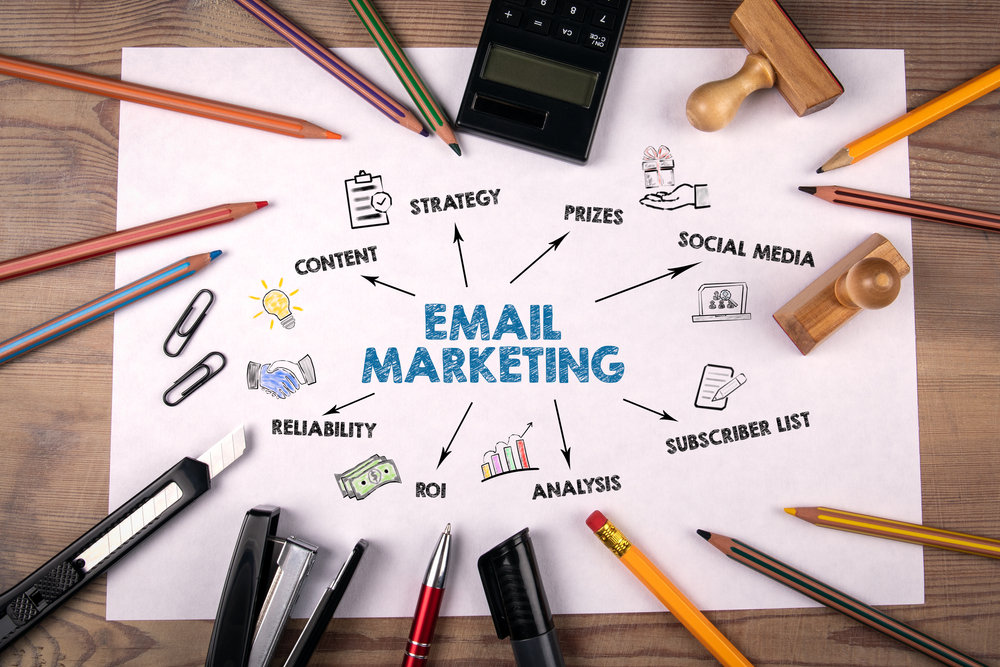![]() Posted by Cameron Francis
on
07 Nov , 2023
in
Digital Marketing
Posted by Cameron Francis
on
07 Nov , 2023
in
Digital Marketing

In today’s rapidly evolving digital landscape, crafting effective email campaigns has become more vital than ever. The success of email marketing is intrinsically tied to understanding the ever-changing email landscape, complete with its trends, challenges, and innovations. In this guide, we’ll explore pro tips for creating email campaigns that engage and convert.
Understanding the Email Landscape
The current email marketing landscape is a dynamic realm. It’s marked by a continuous evolution of best practices, emerging trends, and the ever-present challenge of standing out in a crowded inbox. Keeping abreast of these developments is essential for success, whether it’s embracing the growing influence of mobile devices, grappling with spam filters, or capitalising on the resurgence of personalised content.
Define Your Campaign Goals
Clearly defined goals serve as the foundation for every successful email campaign. They provide direction, focus, and a benchmark for measuring success. Setting clear and well-defined goals for each email campaign is of paramount importance. Here’s why:
- Direction and Focus: Campaign goals provide a clear direction and purpose for your email marketing efforts. They act as guiding stars, ensuring that every element of your campaign aligns with your intended outcomes.
- Measuring Success: Well-defined goals serve as measurable benchmarks. They enable you to gauge the effectiveness of your campaign by comparing the achieved results to your initial objectives.
- Enhanced Planning: When you know what you want to achieve, you can plan your campaign accordingly. Whether it’s crafting content, designing visuals, or selecting your target audience, your goals inform every step of your campaign.
- Adaptability: Clear goals offer adaptability. If you notice that your campaign isn’t progressing as intended, you can adjust your strategies to realign with your objectives.
Audience-Centric Campaigns
Creating audience-centric email campaigns involves understanding your audience’s preferences, behaviors, and demographics. This understanding is vital for several reasons:
- Relevance: When you tailor your emails to your audience, you’re more likely to deliver content that’s relevant to their interests and needs. This relevance is the key to engagement and conversion.
- Increased Open Rates: Knowing your audience’s preferences allows you to send emails at times when they’re most likely to open and engage with them. This can lead to higher open rates and better results.
- Segmentation: Demographic information and behavioral insights enable audience segmentation. Segmented emails are more effective because they allow you to send highly relevant content to specific groups, enhancing the chances of conversion.
- Building Trust: Showing that you understand your audience fosters trust. Trust is a vital factor in building long-term relationships with your subscribers.

Craft Engaging Subject Lines
Subject lines are the gatekeepers to your emails. If they don’t entice recipients to open the email, the rest of your content won’t matter. Here are some tips for crafting attention-grabbing subject lines:
- Personalisation: Personalised subject lines, including the recipient’s name, add a personal touch that captures attention.
- Urgency and Scarcity: Creating a sense of urgency or scarcity in subject lines can prompt immediate action. Phrases like “limited time offer” or “last chance” can be effective.
- Relevance: The subject line should closely align with the email’s content. A subject line that promises something in the email should deliver on that promise.
- Curiosity: Pique curiosity without giving away the entire message. A little intrigue can entice recipients to open the email to satisfy their curiosity.
- A/B Testing: Experiment with different subject lines to determine what resonates best with your audience. Regular A/B testing helps refine your subject line strategies over time.
Tailoring Content for Relevance
The power of personalisation and audience segmentation in email marketing cannot be overstated. Here’s how they contribute to delivering relevant content:
- Personalisation: When you address recipients by their names and tailor content to their preferences and behaviors, it creates a sense of connection. Personalisation makes the recipient feel valued and understood, increasing the chances of engagement.
- Audience Segmentation: Segmenting your email list based on demographics, purchase history, or behavior allows you to send highly relevant content to specific groups. For example, you can send different emails to new subscribers, loyal customers, or those who have abandoned their carts. This tailored approach increases the relevance of your emails and boosts conversion rates.
- Enhanced Engagement: Relevance is the driving force behind engagement. When recipients receive content that aligns with their interests and needs, they’re more likely to open, read, and act on your emails. Whether it’s making a purchase, signing up for a webinar, or sharing content, relevance is the key to conversion.
- Increased Retention: Personalisation and segmentation are not only valuable for acquiring new customers but also for retaining existing ones. By consistently delivering content that matters to your subscribers, you can build long-term relationships and foster loyalty.
Creating Content That Converts
Crafting email content that converts is a mix of art and strategy. Here are tips for creating compelling and visually appealing email content:
- Clear and Compelling Copy: Keep your message clear, concise, and focused on your goal. Highlight the benefits and value that your product or service offers.
- Visually Engaging Elements: Incorporate visuals like images and videos to make your emails visually appealing. Visual content can convey your message more effectively than text alone.
- Mobile Optimisation: Ensure your emails are mobile-friendly. With a significant portion of email opens happening on mobile devices, responsive design is essential for a seamless user experience.
- Hierarchy and Readability: Use headings, subheadings, and bullet points to structure your content. This makes it scannable and easy to read. Pay attention to font size and contrast for readability.
- Compelling Calls to Action (CTAs): Every email should feature a clear and persuasive CTA that guides recipients on the desired action, whether it’s making a purchase, signing up for a webinar, or downloading a resource.
- Consistency with Branding: Maintain consistency in branding elements like colors, fonts, and tone of voice. A consistent brand identity builds trust and recognition.
- Testing and Optimisation: Regularly test different elements of your email content, including headlines, images, and CTAs. Analyse the results and use A/B testing to optimise your content for better performance.
The Power of Clear CTAs
Clear and persuasive Calls to Action (CTAs) play a vital role in prompting desired responses in email marketing:
- Guiding Action: CTAs serve as signposts that direct your recipients on what action to take. Whether it’s “Shop Now,” “Learn More,” or “Subscribe Today,” a well-crafted CTA leaves no ambiguity about the next step.
- Boosting Conversions: A compelling CTA can significantly increase the chances of conversion. It acts as the final push that turns a reader into a customer, a subscriber, or an engaged user.
- Creating Focus: CTAs bring focus to your email content. They let recipients know the primary purpose of the email, making it easier for them to decide whether to engage.
- Driving Engagement: CTAs can encourage various forms of engagement, from making a purchase to sharing content or signing up for an event. They are a critical tool for achieving the goals of your email campaign.
- Enhancing Readability: Clearly designed CTAs, whether in the form of buttons or links, make your email more scannable. They break up the text and draw attention to the most critical parts of your message.
Responsive Design: Optimising for All Devices
Responsive email design is essential to ensure compatibility across various devices:
- Mobile-Friendly: With a significant portion of email opens happening on mobile devices, responsive design ensures that your emails look and function correctly on smartphones and tablets. It prevents issues like distorted images or unreadable text.
- Improved User Experience: Responsive design enhances the user experience by adapting the email layout to the screen size. This makes it easier for recipients to read, engage with, and respond to your emails.
- Wider Reach: Emails that aren’t mobile-responsive risk alienating a substantial portion of your audience. Responsive design ensures your message reaches the widest possible audience, regardless of the devices they use.
- Consistency: A consistent and professional appearance on all devices reinforces your brand’s image. It shows that you’re attentive to detail and invested in delivering quality content.
- Lower Unsubscribe Rates: When recipients can easily read and interact with your emails, they are less likely to become frustrated and unsubscribe. Responsive design can contribute to retaining your subscribers.
A/B Testing: Experimenting for Improvement
A/B testing offers several benefits to refine elements and optimise campaign performance:
- Data-Driven Insights: A/B testing provides valuable data on what works and what doesn’t. By comparing two variations of an element (such as subject lines, visuals, or CTAs), you gain insights into recipient preferences and behaviors.
- Optimised Content: Through testing, you can continually refine your email content to better resonate with your audience. This optimisation leads to improved engagement and conversion rates.
- Enhanced Personalisation: A/B testing allows you to personalise content based on what performs best. This tailored approach can lead to higher click-through and conversion rates.
- Better Decision Making: Testing helps you make data-driven decisions rather than relying on assumptions. It reduces guesswork and hones your strategies for more effective campaigns.
- Continuous Improvement: A/B testing is an ongoing process that allows you to refine your email marketing over time. It’s a critical tool for staying relevant and competitive in a dynamic digital landscape.
Automate Smartly
Insights on using marketing automation to streamline campaigns and nurture leads:
- Efficiency and Consistency: Email marketing automation streamlines repetitive tasks like sending welcome emails, follow-ups, and lead nurturing. This ensures that every prospect or customer receives consistent communication.
- Lead Nurturing: Automation allows you to create lead nurturing sequences that guide prospects through the sales funnel. Tailored content and responses can significantly improve conversion rates.
- Behavioral Triggers: Automation can be triggered by recipient behavior, such as clicking a link or making a purchase. This enables timely and relevant follow-up emails.
- Segmentation: Automation helps you segment your audience and deliver personalised content. For example, you can send different emails to first-time customers, repeat buyers, or those who’ve shown specific interests.
- Time Savings: By automating routine tasks, your team can focus on strategy, creativity, and analysing data to improve campaign performance. It maximises your efficiency and productivity.
Strategising Send Times
Strategising the timing and frequency of email campaigns is crucial for achieving maximum impact. Here’s a detailed look at this aspect of email marketing:
- Audience Behavior Analysis: The optimal send times can vary depending on your target audience. By analysing recipient behavior and open rates, you can determine when your audience is most likely to engage with emails. This may involve considering time zones, weekdays versus weekends, and even specific hours.
- Frequency Balancing: The frequency of your email campaigns should strike a balance. Overwhelming your subscribers with too many emails can lead to unsubscribes and disengagement. On the other hand, sending emails too infrequently can lead to reduced brand visibility. Test different frequencies to find the sweet spot for your audience.
- Automation Scheduling: Marketing automation tools offer the advantage of scheduling emails at optimal times based on recipient behavior. For example, if a subscriber often opens emails in the evening, an automation system can deliver emails during those hours. Automation ensures your emails reach recipients when they are most likely to be receptive.
- Segmentation and Timing: Audience segmentation allows you to tailor send times for specific groups. For example, you can send promotional emails to a group of subscribers in a different time zone than your educational content recipients. Segmentation ensures that your emails are not only timely but also relevant to each group.
- Response Monitoring: Continuously monitor your email campaign responses and use the data to refine your timing strategy. Metrics like open rates, click-through rates, and conversion rates provide insights into the effectiveness of your email timing. Adjust your strategy as needed to optimise results.
Data-Driven Decision Making
Data-driven decision making is a cornerstone of effective email marketing. Here’s an in-depth exploration of this concept:
- Performance Analysis: Email campaign metrics provide invaluable insights into the effectiveness of your strategies. Analyse key performance indicators like open rates, click-through rates, conversion rates, and unsubscribe rates. By understanding how recipients are engaging with your emails, you can make data-driven decisions.
- Segmentation Refinement: Use data to refine your audience segmentation. Look for patterns and behaviors among your subscribers. For instance, you may discover that certain segments prefer specific content types or respond better to certain subject lines. Refining your segmentation increases the relevance of your emails.
- Content Optimisation: Data helps you identify content that resonates with your audience. Analyse which emails generate the most engagement and conversions. Use this information to create more of the content that works and refine or eliminate content that doesn’t perform well.
- A/B Testing Insights: A/B testing, which involves experimenting with different email elements, relies on data to determine the winning variations. Analyse A/B test results to make informed choices about subject lines, visuals, CTAs, and other components.
- Lifecycle Marketing: Track where recipients are in the customer journey, from new leads to loyal customers. Use this data to send emails tailored to each stage of the lifecycle. A lead may need different content than a long-time customer.
Compliance and Privacy
Compliance with data protection and privacy regulations is vital to maintain trust and credibility. Here’s an in-depth look at this crucial aspect of email marketing:
- Data Protection Laws: Compliance with data protection laws is a legal obligation. In Australia, this primarily includes adherence to the Privacy Act and the Spam Act. Ensure that your email marketing practices align with these regulations to avoid legal issues.
- Subscriber Consent: Respect subscriber consent and permissions. Only send emails to individuals who have explicitly opted in to receive communications from your brand. Implement a clear and easy-to-use opt-out process for those who no longer wish to receive emails.
- Data Security: Safeguard the data you collect from breaches and misuse. Data breaches can damage your reputation and lead to legal repercussions. Implement strong security measures to protect your subscriber data.
- Transparency: Be transparent about how you collect, store, and use subscriber data. Provide a clear privacy policy that explains your data practices. Transparency fosters trust among your audience.
- International Regulations: If you conduct international email marketing, be aware of global data protection regulations, including GDPR in Europe. Different regions have different rules, and compliance is essential to avoid fines and legal complications.
- Regular Compliance Audits: Periodically review and audit your email marketing practices to ensure ongoing compliance. Seek legal counsel or privacy experts to guide your compliance efforts, especially if you have concerns about navigating complex regulations.
Final Thoughts
In summary, crafting effective email campaigns requires a combination of art and science. These pro tips for email marketing can serve as a valuable guide to help you achieve outstanding results. By staying informed about the email landscape, defining clear campaign goals, focusing on audience preferences, and optimising content, you can supercharge your email marketing efforts. At ETRAFFIC, we specialise in helping businesses unlock the full potential of their email marketing campaigns.
Please call us at ETRAFFIC today at 1300 887 151 or book a free strategy session below.






